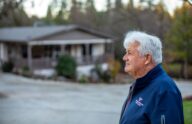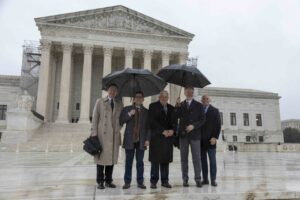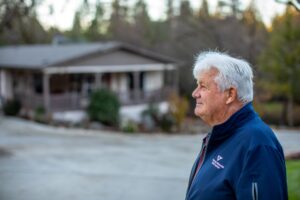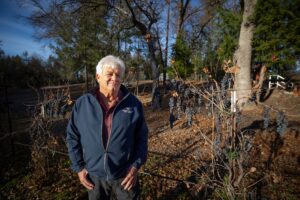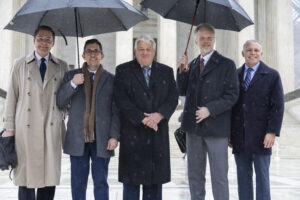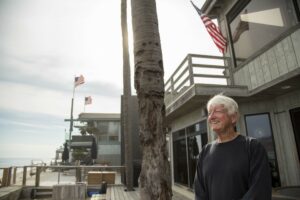The government had George Sheetz ‘over a barrel.’ He took his case to the Supreme Court—and won.
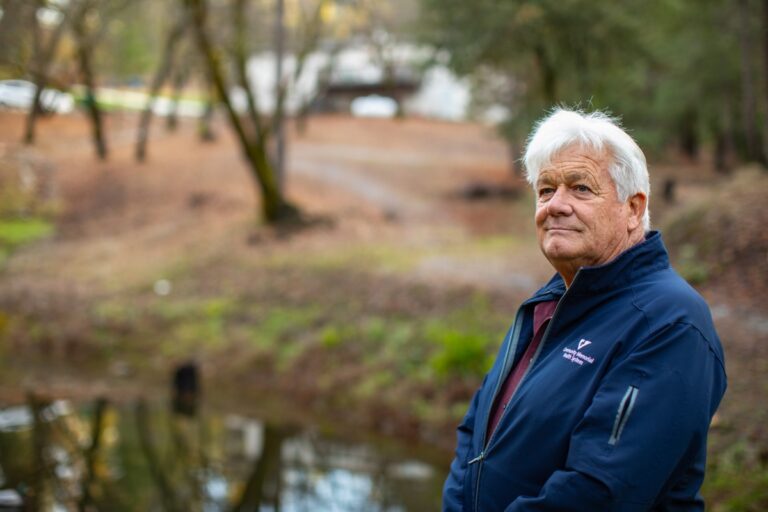
This post has been updated to reflect George Sheetz’s April 12 victory at the Supreme Court.
Picture this: You’re a 65-year-old retiree who bought a small parcel of land in El Dorado County, California. In your career you worked your way up from $5-an-hour laborer to head of your own engineering contracting company. Your plans are modest: You’re installing a manufactured home on your land. You’ve been careful not to spend more money than you have. You still work sometimes as a consultant, even though you’re retired, so that you and your wife can live comfortably. You paid in full for your land—it took you three years, but it’s yours.
Unfortunately, the government is less careful with its money.
El Dorado County is in the middle of a 20-year plan to spend over $800 million improving the area’s roads. The problem? El Dorado doesn’t have $800 million to spend. So to fund its plan, the county is slapping “traffic impact fees” on anyone who applies for a building permit, including you.
To build a small, manufactured home on your own land, you’re forced to pay the government a traffic impact fee of over $23,000 that will go toward the government’s multimillion-dollar project.
Do you accept the exorbitant fee and move on with your life? Or do you fight the county, taking your case as far as it will go?
George Sheetz decided to fight. “Your whole life you get beat down so many times,” said George. “It’d be nice to win one.”
The case of Sheetz v. El Dorado County was argued at the United States Supreme Court on January 9, 2024, with Pacific Legal Foundation serving as co-counsel to Paul Beard from Pierson Ferdinand. George traveled to Washington, DC, for the argument.
And on April 12, 2024, the Supreme Court announced a unanimous ruling in George’s favor.
The good life
El Dorado County, east of Sacramento, has a history. It was home to the California Gold Rush of 1849, when so many ambitious Americans flocked to the area that a new iteration of the American Dream, the “California Dream,” was born.
“For most of us, the California Dream is simply a vision of the good life,” James Rawls writes. “It once was seen glittering in the California gold fields…. Founded on expectation and hope, the California Dream promises to fulfill our deepest longings for opportunity and success, warmth, sunshine and beauty, health and long life, freedom, and even a foretaste of the future.”
George Sheetz is from New Jersey. Like gold prospectors, he moved west to California chasing opportunity: His wife’s family, who’s from California, encouraged him to go to Los Angeles for work.
“They said, ‘Someone as talented as you could make a bundle of money,’” George remembered.
But he hated Los Angeles.
“I felt like I was in prison,” he said. After five years, he was done. “I told my wife, ‘I’m going up to the mountains. I’m going to get a job for $5 an hour and go fishing. You can stay here in this cesspool or you can go with me.”
She went with him. They moved to El Dorado County, where George spent 30-odd years as an engineering contractor. When George was about ready to retire, he bought a vacant plot. It was an old gold mining site that he had to clean up. “The more I worked on it, the more I fell in love with it,” he said.
He planned to install a manufactured home on the property. A manufactured home is prefabricated in a factory, rather than built from the ground up. George thought it would require less government red tape than an original construction project.
He wasn’t counting on a $23,420 traffic impact fee.
Government extortion
Before George brought his case, the Supreme Court had already ruled that the government can’t abuse the permitting process to impose conditions on property owners that have no “essential nexus” with the building project being permitted. That was the Court’s holding in Nollan v. California Coastal Commission (1987), Pacific Legal Foundation’s first Supreme Court victory. In that case, the Coastal Commission tried to make Pat Nollan’s building permit conditional on him giving up a third of his property for public use. Justice Antonin Scalia said it was “the same as if California law forbade shouting fire in a crowded theater, but granted dispensations to those willing to contribute $100 to the state treasury.”
That certainly seems like what El Dorado County did to George Sheetz.
The legal difference between Nollan and Sheetz is that in Pat Nollan’s case, the permit conditions came from regulators at the California Coastal Commission. In George’s case, El Dorado County actually passed legislation to establish the traffic impact fee. The government’s argument is that legislative conditions shouldn’t be subject to the same constitutional scrutiny as bureaucratic conditions.
But if that were right, the hypothetical that Scalia imagined in Nollan—a California law forbidding shouting fire in a theater while granting dispensations for $100—would pass constitutional muster.
“It doesn’t matter what government actor does the imposing of the exaction,” Paul Beard, a former PLF attorney who has been litigating George’s case for years, told Law360 before the oral argument. “It’s still subject to the same heightened scrutiny.”
Sheetz v. El Dorado County
When George first found out about the $23,420 traffic impact fee, he felt sick to his stomach. He went to the county office.
“They said, ‘This is just the way it is,’” he remembered. “And to accept it. And, ‘You don’t have to build. No one’s making you build.’”
When you’re dealing with the government, George said, “they pretty much have you over the barrel.”
But Supreme Court precedent and the Constitution were on George’s side. In Nollan, the Supreme Court called the government’s actions “an out-and-out plan of extortion.” In a later PLF victory, Koontz v. St Johns River Water Management District (argued by Paul Beard when he was at PLF), the Supreme Court extended the precedent set in Nollan to monetary exactions in addition to land.
George paid the fee under protest so that he could build his home—then he sued El Dorado County. By the time his lawsuit reached the Supreme Court, it had been going on for seven years. George is now 72.
“My God, the law does not move along at a very good pace,” George said. “I see why people give up sometimes.”
George was not asking for much: just the freedom to build on his property without being extorted by his own government. Surely that freedom is part of the American Dream and the California Dream.
In its unanimous April 12 decision, the Supreme Court agreed with George: Legislatures can’t violate property owners’ constitutional rights.
As Justice Amy Coney Barrett wrote in the opinion, “[T]here is no basis for affording property rights less protection in the hands of legislators than administrators. The Takings Clause applies equally to both—which means that it prohibits legislatures and agencies alike from imposing unconstitutional conditions on land-use permits.”
It was, The Wall Street Journal quipped, “a bad day for greedy politicians at the Supreme Court.” The victory—PLF’s 18th win at the Supreme Court—protects property owners across the country from government extortion. At a time when Americans desperately need affordable housing to be built, the Sheetz decision lowers costs by getting rid of excessive permit fees.
George Sheetz already built his manufactured home. His victory isn’t just about him; it’s about stopping the government from extorting anyone else.
When PLF got involved in George’s case, we asked him what a victory would mean to him. George said, “I want to go back into that county building, look ’em right in the eye, and say: ‘Well, how do you like me now?’”


